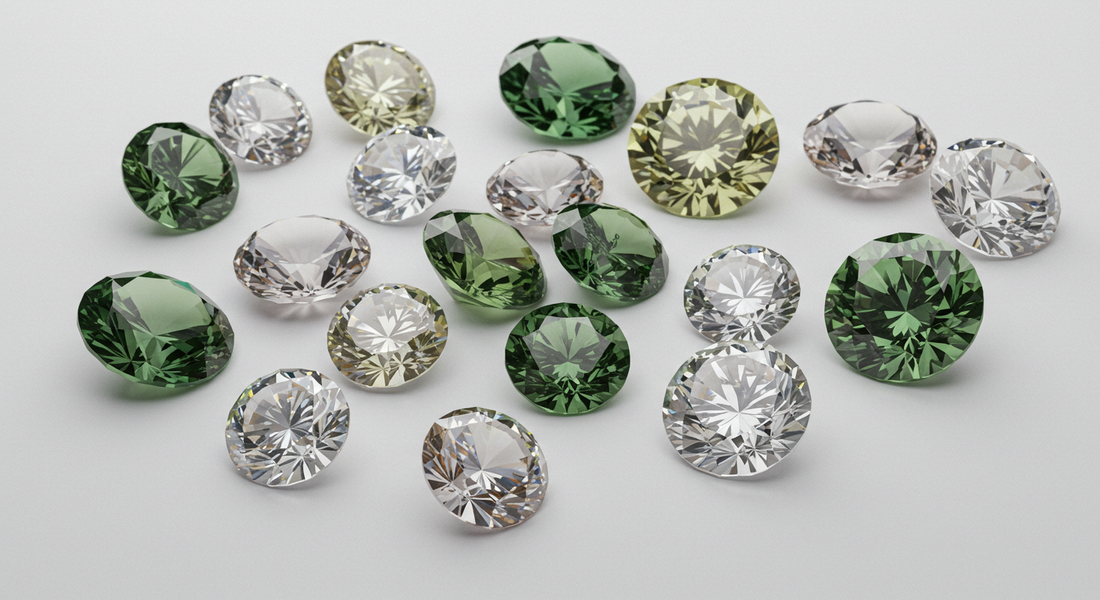
Diamond vs. Moissanite vs. Zirconia: Which is the Best Choice for You?
Share
When choosing a special piece of jewelry – be it an engagement ring, earrings or necklace – the center stone is always the star. But with so many options on the market, how do you decide between diamond , moissanite and cubic zirconia ? In this guide, we’ll reveal the characteristics, advantages and disadvantages of each one so you can make the right choice.
1. Diamond: The Eternal Classic
What is it?
THE diamond is a natural gemstone formed under high pressure in the Earth's mantle, composed of pure carbon. It is the hardest substance known to man (10 on the Mohs scale).
Features:
-
Luster : Reflects light uniquely due to its high refractive index (2.42) and dispersion ("fire").
-
Durability : Scratch and wear resistant, ideal for daily use.
-
Value : High cost due to rarity and demand.
-
Origin : Natural (mining) or laboratory (synthetic diamonds, with the same chemical composition).
Pros:
-
Symbolic status (tradition, luxury).
-
Long-term investment (retains value in the market).
-
Ethical options available (certification Kimberley Process or laboratory diamonds).
Cons:
-
High price.
-
Traditional mining can involve socio-environmental conflicts.
For Whom?
Those who prioritize tradition, absolute durability and investment in monetary value.
2. Moissanite: The Shine of the Future
What is it?
THE moissanite it is a stone made of silicon carbide , originally found in meteorites, but now produced in laboratories. Almost as hard as diamond (9.25 on the Mohs scale).
Features:
-
Brilliance : More "fire" than diamond (refractive index of 2.65), with intense colored reflections.
-
Durability : Almost as strong as diamond.
-
Value : Costs 80-90% less than a natural diamond of similar size.
-
Origin : 100% synthetic (eco-friendly and conflict-free).
Pros:
-
Affordable price with exceptional shine.
-
Sustainable and ethical.
-
Almost indistinguishable from diamond to the naked eye.
Cons:
-
More "colorful" shine may not be to everyone's taste.
-
Lower resale value.
For Whom?
Those looking for guilt-free luxury, intense shine and savings.
3. Cubic Zirconia: The Popular Alternative
What is it?
THE cubic zirconia (or CZ) is a synthetic stone made of zirconium dioxide . The most affordable of the three, with moderate hardness (8-8.5 on the Mohs scale).
Features:
-
Brilliance : Less intense than diamond and moissanite, with a tendency to become dull over time.
-
Durability : Risk of scratches and loss of shine after a few years.
-
Value : Very low cost (up to 95% cheaper than a diamond).
-
Origin : Large-scale industrial production.
Pros:
-
Ideal for temporary jewelry or tight budgets.
-
Available in assorted colors.
Cons:
-
Shorter lifespan.
-
Less "natural" look for those seeking sophistication.
For Whom?
Anyone who wants a beautiful piece of jewelry for specific occasions or style testing.
Quick Comparison: Diamond vs. Moissanite vs. Zirconia
| Feature | Diamond | Moissanite | Zirconia |
|---|---|---|---|
| Hardness (Mohs) | 10 | 9.25 | 8-8.5 |
| Shine | White and sparkling | colored fire | Less intense |
| Price (1ct) | €2,000-€15,000+ | €300-€600 | €10-€50 |
| Origin | Natural/Lab | Laboratory | Laboratory |
| Sustainability | Variable | High | Moderate |
How to Choose?
-
Define Your Goal :
-
Investment/Inheritance : Diamond.
-
Cost-Benefit : Moissanite.
-
Temporary Fashion : Zirconia.
-
-
Prioritize Values :
-
Ethical and eco-friendly? Moissanite or lab-grown diamond.
-
Tradition? Natural diamond.
-
-
Visually Test :
-
Compare the stones in person: moissanite is more "rainbow", diamond is more "sparkling white".
-
Frequently Asked Questions
1. Does Moissanite look "fake"?
No! Most people don't notice the difference, especially in classic cuts (like the round brilliant).
2. Is zirconia worth it for engagement rings?
It depends: if it's a temporary commitment or if you don't mind changing the stone after a few years, it might be an option.
3. Are lab-grown diamonds "real"?
Yes! They are chemically and visually identical to natural ones, but up to 40% cheaper.
Conclusion
There is no right answer – just the choice that best aligns with your heart, your wallet and your lifestyle. While the diamond is the unbeatable icon, the moissanite conquest by brilliance and consciousness, and the zirconia for practicality.
💍 Final Tip: Regardless of the stone, invest in a good goldsmith to ensure the fit and safety of the jewel!
Did you like it? Share your questions or experiences in the comments!
